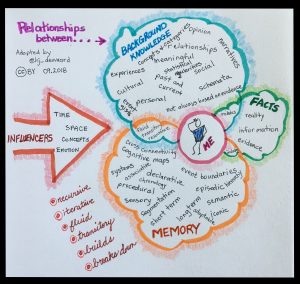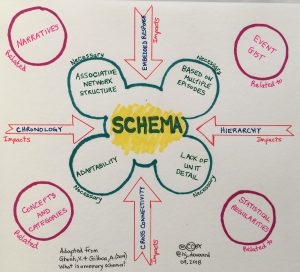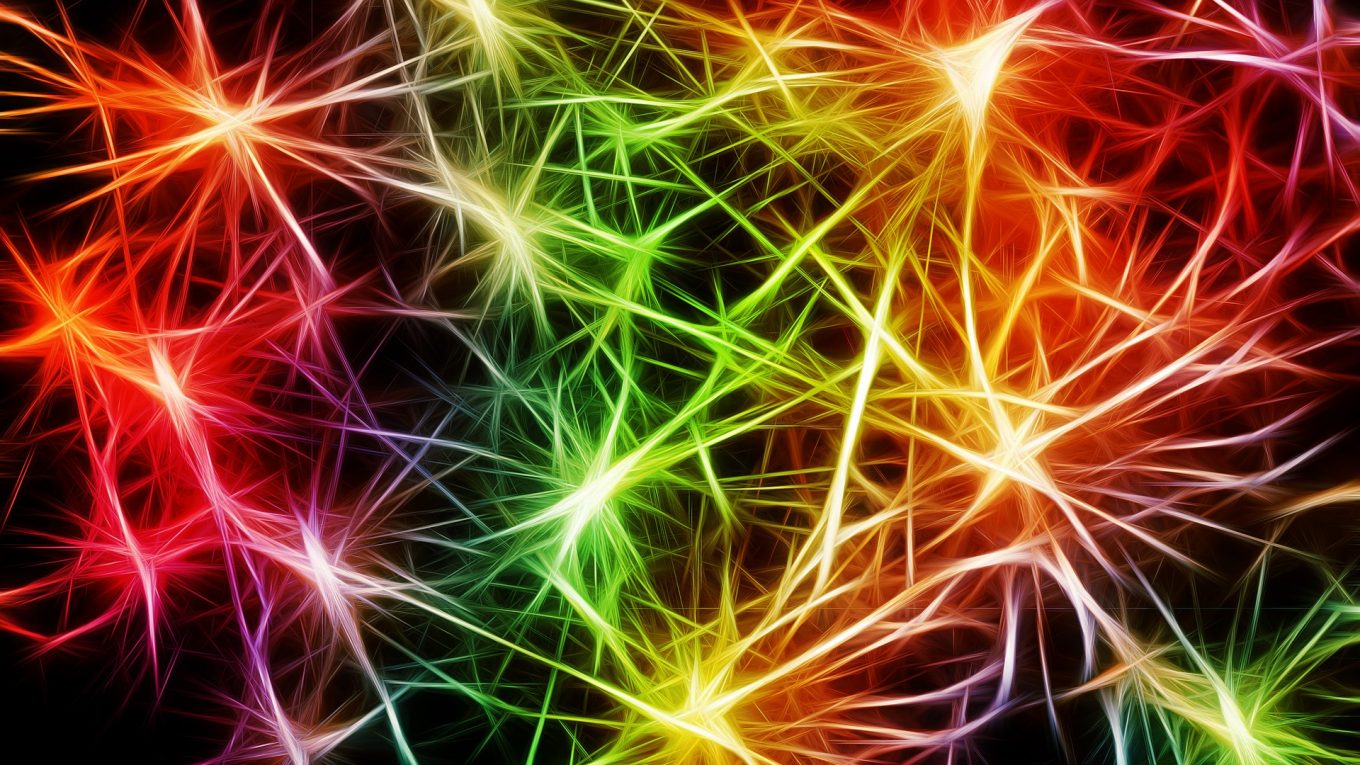PhD hallucinations
This is a response for the question prompts for Week 3 in Cognition and Learning, 6411.
I’ve been immersing myself into this topic, about background knowledge, since I’ve got a reading response prepared as part of this week’s topic. I’m finding some truth in what Willingham (2009) states about the more we know, the more we’ll know, or the rich get richer. But I’m also struck by the concluding words from Anil Seth’s (2017) Ted Talk, when he states that a “greater sense of understanding comes a greater sense of wonder”. My inquiry into background knowledge has certainly been informed by my prior knowledge of this topic. Reading the hard bound set of encyclopedias as a child, purchased by my parents at great cost, may not have made me a brilliant neuroscientist, but my awareness of neurobiology and brain psychology was certainly shaped by those types of experiences. The notion of schemata and frameworks for memory enhances my understanding of the structures of the brain, building my sense of wonder at how this complicated, complex, interconnected, neural network functions to bring me a quality of life, encapsulating a rich repository of memories on which to reflect.
Do you agree with Willingham’s overall assertion that background knowledge – factual knowledge – is key and inseparable from learning?

Is factual knowledge, as encoded, stored, and retrieved within the brain, a key to learning?
Yes. (see Figure 1)
Based on all the evidence from neurobiological studies, our memory schema, as it describes what we learn and know, are constructed from facts, background information, and personal experiences, which all factor into our individual constructs and perceptual predictions of reality (Brunec, Moscovitch & Barense, 2018; Clewett and Davachi, 2017; Ghosh & Gilboa, 2014; Gilboa & Marlatte, 2017; Morton, Sherrill & Preston, 2017; Norris, 2017; Seth, 2017; Willingham, 2009). What we know about our embodied self is grounded in what we’ve already experienced, so we can make a best guess based on consciousness (Seth, 2017).
Sections of the brain are activated by memories. Ghosh & Gilboa (2014) posit that the ventromedial prefrontal cortex (vmPFC) plays a role in memory. The hippocampus appears to be in competition and/or synchronization when memory events are activated or encoded (Gilboa & Marlatte, 2017). Memories are integrated into cognitive maps “supported by bidirectional interactions between hippocampus and medial prefrontal cortex (mPFC)” (Morton, et al., 2017, p. 161) and are bounded by “spatial and nonspatial contextual segmentation” (Brunec et al., 2018, p. 637). Memory clustering is essential to “derive meaning from past experience” (Clewett and Davachi, 2017, p. 186) and our prior knowledge allows us to make inferences based on the temporal organization of events stored in episodic memory. Norris (2017) reviews neuroimaging data to support the view that short term (STM) and long term memory (LTM) are distinctly different, with LTM activating STM. Yet, the more I know about memory, background knowledge, and facts, the more I wonder – what does this mean for students in the classroom, each bringing their unique schemata about concepts to the topics being explored in a course of study?
How would background knowledge and perception affect differentiated instruction if everyone in the class comes in with differing levels of background knowledge and perceptions?
Classrooms, at any age or stage of learning, from my experience, come with a wide range, and sometimes extensive gaps, in background knowledge, experiences, and conceptions, based on personal narratives, concepts and categories, event gists, and statistical regularities (see Figure 2 adapted from Ghosh & Gilboa, 2014). By spending time on building a communal understanding of a topic e.g. the making of maple syrup, everyone in the classroom has a shared memory, even though there may be variations in those individual differences in personal schemas about making maple syrup. Factual knowledge about maple syrup making will improve student’s memory of maple syrup related information, as new information is “instantiated”, through a process of assimilation and accommodation, as it is acquired, encoded, stored and retrieved (Gilboa & Marlatte, 2017). Willingham (2009) outlines how background knowledge supports learning by providing vocabulary, chunking information, bridging logic gaps in text, and guides how ambiguous materials can be interpreted (p. 36). In the classroom, building collaborative background knowledge, about making maple syrup for example, can be done through shared experiences (e.g. taking a trip to a maple syrup making shack), constructing concept maps, and using a ‘quad text set framework’ (Lupo, Strong, Lewis, Walpole, & McKenna, 2017) can support those with gaps in their individual knowledge schema. The universal design for learning principles, as outlined by CAST, provide these suggestions for activating and enhancing prior knowledge – link to prior knowledge using images, use advance organizers like concept maps, use demonstration and modelling, explicitly make cross-curricular connections, and use relevant analogies and metaphors (CAST website). It’s important to ensure that building better background knowledge is an integral part of every lesson or unit taught in the classroom.
Did you feel surprised at parts of this video?
One part of this video surprised me. The premise that we are all hallucinating, making our best guess predictions, and that reality IS what we agree it to be, is somewhat surprising. Our awareness, both inner and external, comes from perceptual predictions, based on sensory signals. The surprising part that comes from this is that our world is merely a series of controlled hallucinations constructed by our brains, and that we are all generally hallucinating together.
Welcome to my PhD hallucinations!
It harkens back to the blind men and the elephant related in an Indian poem. There is potential for building a better sense of self, as an embodiment within reality, through collaboration and openly sharing information, as represented in the Indian poem. While there may be many ways to achieve consciousness in this world, there is one that eludes, that of artificial intelligence (Seth, 2017).
References
Brunec, I. K., Moscovitch, M., & Barense, M. D. (2018). Boundaries shape cognitive representations of spaces and events. Trends in Cognitive Sciences, 22(7), 637-650.
Clewett, D. & Davachi, L. (2017). The ebb and flow of experience determines the temporal structure of memory. Current Opinion in Behavioural Sciences, 17, 186-193.
Ghosh, V. & Gilboa, A. (2014). What is a memory schema? A historical perspective on current neuroscience literature. Neuropsychologia, 53, 104-114.
Gilboa, A. & Marlatte, H. (2017). Neurobiology of schemas and schema-mediated memory. Trends in Cognitive Sciences, 21(8), 618-631.
Lupo, S., Strong, J., Lewis, W., Walpole, S., & McKenna, M. (2017). Building background knowledge through reading: Rethinking text sets. Journal of Adolescent & Adult Literacy, 61(4), 433-444.
Morton, N. W., Sherrill, K. R., & Preston, A. R. (2017). Memory integration constructs maps of space, time, and concepts. Current Opinion in Behavioural Sciences, 17, 161-168.
Norris, D. (2017). Short-term memory and long-term memory are still different. Psychological Bulletin, 143(9), 992-1009.
Seth, A. (2017, July 18). Your brain hallucinates your conscious reality. TED video. Retrieved from https://youtu.be/lyu7v7nWzfo
UDL guidelines, checkpoint 3.1, activate or supply background knowledge. (2018). Center for Applied Special Technology (CAST). Retrieved from http://udlguidelines.cast.org/representation/comprehension/background-knowledge
Willingham, D. (2009). Why don’t students like school? San Francisco, CA: Jossey Bass.
